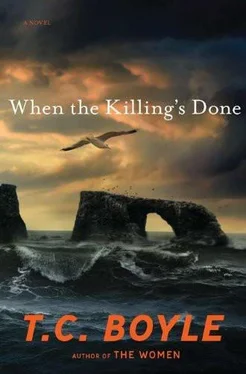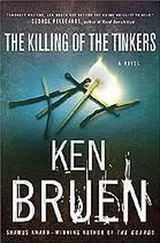“Music’s pretty loud,” he observes.
She turns around now, her hands arrested in the act of halving tomatoes. “I left my iPod at work.”
He has nothing to say to this, though she knows he hates Micah Stroud and Carmela Sexton-Jones and all the other new-wave folkies she plays in random shuffle through most of the day at her desk. When they’d first met, the first week they were together, she’d put on a CD she thought he might like and he’d waited through the better part of a sixteen-ounce can of Guinness before passing judgment. “I don’t know how to say this without being too blunt or anything,” he said, giving her his mildest look to show that he was only trying to be sincere, “but how can you listen to this. . whatever you want to call it? I mean, give me rock and roll any day, the White Stripes, the Strokes, the Queens of the Stone Age.” It was a challenge, a testing of the waters, and she didn’t blame him for it — in fact, it was to his credit, because people didn’t have to echo each other like twins to get along in a relationship — but still she stiffened. “At least they’re committed,” she said, “at least they sing about something other than sex and drugs.” “What’s wrong with sex?” he’d countered, too quickly, the faintest shadow of a grin creeping across his lips, and she knew she’d been had. He counted off a beat, letting the grin settle in. “Or, for that matter, drugs?”
“I was just looking in the paper,” he says now, raising his voice to be heard over the music, “to see if there’s an announcement about tonight.”
Despite herself, despite her nerves, she can’t help conjuring the name of the behavior he’s just exhibited — the Lombard effect, which refers to the way people unconsciously elevate their voices to compete with ambient noise, the roar of the restaurant, any restaurant, serving as the most salient example — even as she moves away from the counter, crosses the kitchen and strides into the front room to kill the volume on the stereo. At which point the cars and trucks and honking horns rush back into her life as if there’d never been anything else. And why couldn’t they put the freeways underground, deep down, and make a park out of all that recovered acreage on top? Or a walking path? A garden to feed the hungry? Trees, weeds, anything? If she had enough money — say, five hundred billion or so — she’d buy up all the property in town, raze the buildings, tear out the roads and reintroduce the grizzly bear.
“Here, here it is,” he calls out.
The notice, a pinched little paragraph in the Upcoming Events section of the local paper, is squeezed between the announcement of a performance of selections from “Les Sylphides” by the Junior Dance Studio of Goleta and a lecture on Chumash ethnobotany at the Maritime Museum:
Lecture and Public Forum
.
Alma Boyd Takesue, Projects Coordinator and Director of Information Resources for the National Park Service, Channel Islands, will address concerns over the proposed aerial control of the black rat population on Anacapa Island. 7:00 p.m., Natural History Museum, 2559 Puesta del Sol, Santa Barbara.
She’s leaning over the table beside him, the print enlarging and receding because she’s left her glasses on the counter, a trim pretty woman of thirty-three, with her mother’s — and grandmother’s — rinsed gray eyes and the muscular, ever-so-slightly-bowed legs and unalloyed black hair she inherited from her father. Which she wears long, down to her waist, and which slips loose now from where she’s tucked it behind her ears to dangle across his forearm as he holds the paper up for her.
“Just the facts,” he says. “I mean, that’s all you can expect, right?”
It’s somehow surprising to see it there in print, this thing she’s been wrestling with privately for the past week made official, set down for the record in the staid familiar type she scans every morning for the news of things. Here is the fact of the news revealed: that she will appear at the place and time specified to make the Park Service’s case for what to her seems the most reasonable and obvious course of action, given the consequences of inaction. And if that action requires the extirpation of an invasive and pernicious species — killing, that is, the killing of innocent animals, however regrettable — then she will show that there is no alternative because the health and welfare, the very existence of the island’s ground-nesting birds, will depend on it. The entire breeding range of Xantus’s murrelet lies between Baja and Point Conception. There are fewer than two thousand breeding pairs. Rats, on the other hand, are ubiquitous. And rats eat murrelet eggs.
“Not much of a come-on, though, is it?”
“No,” she admits, straightening up and then stretching as if she’s just rolled out of bed, and maybe she should have a cup of green tea, she’s thinking, for that extra little jolt of caffeine. She stands there stationary a moment, gazing down at him, at the back of his head and the curiously fleshy lobes of his ears, at the way the hair, medium-length and mink-brown shading to rust at the tips, curls over the collar of his T-shirt and the ceramic beads he wears round his throat on a string of sixty-pound test fishing line. (“Why sixty pounds?” she’d asked him once. “So they won’t break in the surf,” he told her, matter-of-factly, as if he were stating the obvious. “They never come off?” “Never.”) She lays a hand on his shoulder, the lightest touch, but contact all the same. “But then, when you think of what happened last week in Ventura”—she looks into his eyes now and then away again, her lips compressing over the memory, the wounds still fresh and oozing—“maybe we don’t really want a crowd. Maybe we want, oh, I don’t know, maybe thirty people who’ve read the literature—”
“Thirty ecologists.”
Her smile is quick, grateful — he can always lighten the mood. “Yeah,” she says, “I think that’d be about right.”
He’s smiling now too, suspended there above the perspective line of the table like a figure in the still-life painting she’s composing behind her eyelids: the pita on the counter, the late sun breaking through to slant in through the window and inflame the stubble of his cheek, the freeway gone and vanished along with the mood of doom and gloom she’d brought with her into the front room. All is well. All is very, very well. “But I just wanted to be sure,” he says, breaking the spell, “in case you want me out front for crowd control.” He gives it a beat, reaching out to take her hand and run his thumb over her palm, to and fro, caressing her, bringing her back. “No rat lovers, though. Right? Are we agreed on that?”
On the second of December, 1853, the captain of the SS Winfield Scott , a sidewheel steamer that had left San Francisco the previous day for the two-week run to Panama, made an error in judgment. That error, whether it was the result of hubris, overzealousness or a simple mistake of long division, doomed her, and as the years spun out, doomed generations of seabirds too. She had been launched just three years earlier in New York for the run between that city and New Orleans, but in 1851 she was sold and pressed into service on the West Coast, where passenger demand had exploded after the discovery of gold in northern California. Built for heavy seas, some 225 feet long and 34½ feet abeam, with four decks and three masts, she was a formidable ship, named for Major General Winfield Scott, lion and savior of the Mexican War, a gilded bust of whom looked out over her foredeck with a fixed and tutelary gaze. On this particular trip, she carried some 465 passengers and $801,871 in gold and gold dust, as well as several tons of mail and a full crew. Where she picked up her rats, whether in New York or New Orleans or alongside the quay in San Francisco, no one could say. But they were there, just as they were present on any ship of size, then and now, and they must have found the Winfield Scott to their liking, what with its dining salon where up to a hundred people at a time could eat in comfort, with its galleys and larder, its cans of refuse waiting to be dumped over the side and all the damp sweating nooks and holes belowdecks and up into the superstructure where they could live in their own world, apart from the commensal species that provided them with all those fine and delicate morsels to eat. There might have been hundreds of them on a ship that size, might have been a thousand or more, for that matter — no one could say, and the ones that turned up in the traps set by the stewards were mute on the subject.
Читать дальше












